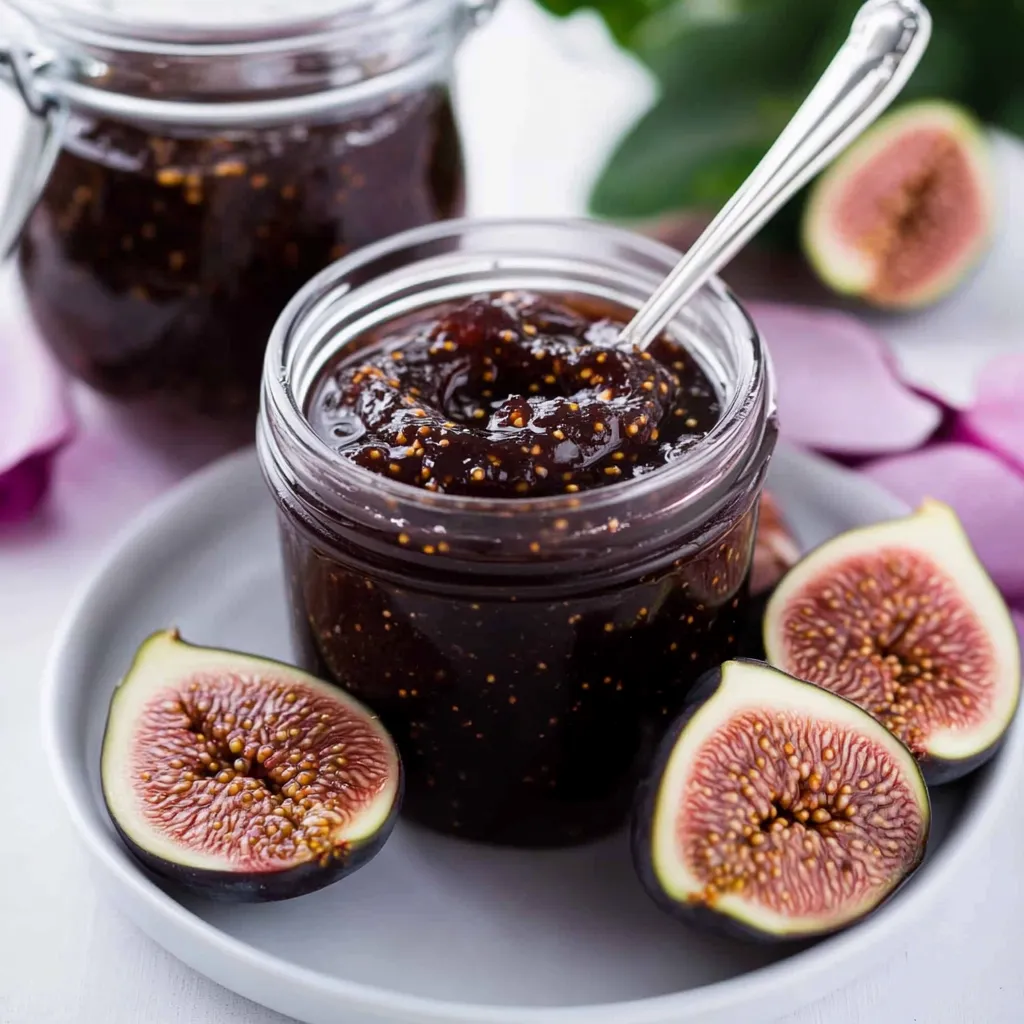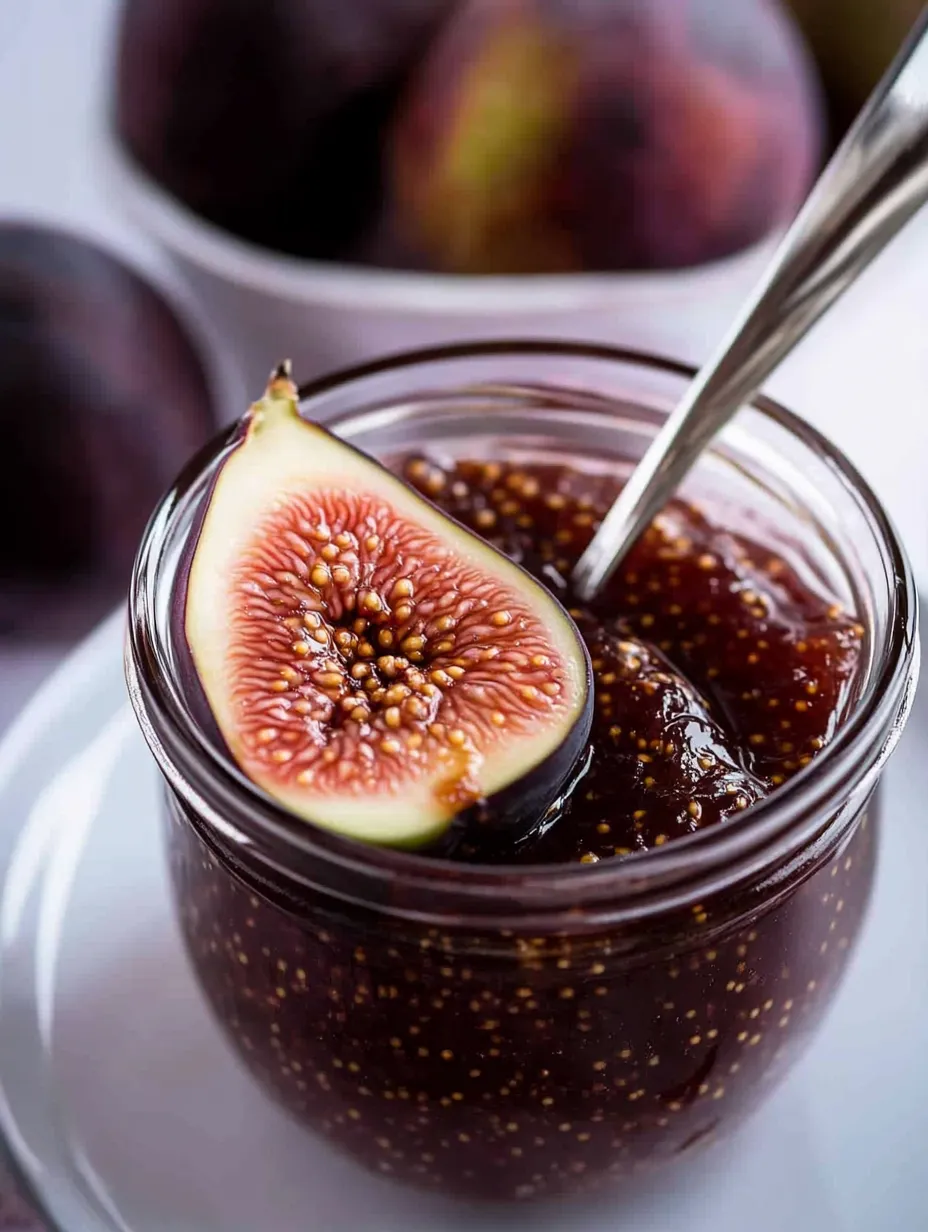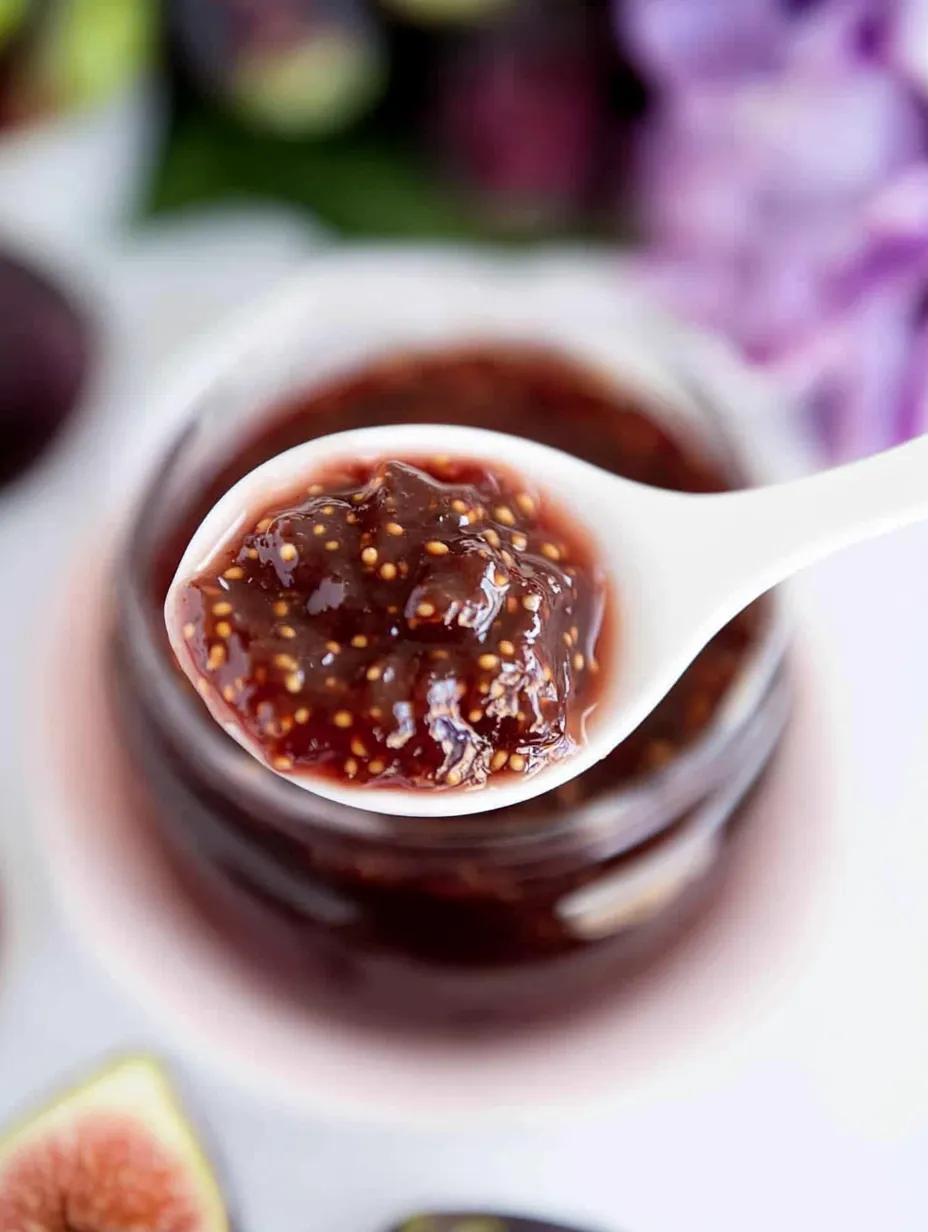 Pin it
Pin it
This extraordinary jam transforms fleeting seasonal figs into timeless jars of ruby sweetness through a simple process that concentrates their natural honey notes. The magic happens as the fruit slowly breaks down and melds with sugar, creating that perfect jammy consistency while preserving the distinctive figgy essence. I perfected this recipe after years of experimenting with various preservation methods, seeking the ideal balance that would honor these luxurious fruits beyond their brief seasonal appearance.
Preserving Perfection
My journey with this jam began during a particularly abundant fig harvest from a neighbor's overloaded tree. What started as a practical solution to prevent waste quickly became an annual tradition marking late summer's transition to fall. Even my grandmother, with decades of jam making experience, requested jars of my version after her first taste. The perfect balance of sweetness and fruit integrity makes this recipe particularly valuable for those seeking to capture seasonal abundance without artificial ingredients or excessive complexity.
Pure Components
- Fresh Figs (2 pounds/1kg): The essential star ingredient with their unique honeyed sweetness and subtle seedy texture that defines this preserve
- Granulated Sugar (2 pounds/1kg): Creates the necessary environment for preservation while enhancing the natural sweetness of the fruit
- Fresh Lemon Juice (3 tablespoons): Contributes essential acidity and natural pectin that helps the jam achieve proper setting consistency
- Filtered Water (1/2 cup/120ml): Provides just enough moisture to prevent scorching during the initial cooking stage without diluting flavor
 Pin it
Pin it
Preservation Technique
- Fruit Preparation:
- Begin with careful selection and preparation of your figs, which creates the foundation for exceptional jam. Choose fully ripe but still firm fruits, ideally harvested within 24 hours of processing for optimal flavor and natural pectin content. Gently wash the figs under cool running water, removing any stems, blemishes, or damaged portions. Using a sharp knife, trim away the woody stem end and quarter each fig, creating pieces large enough to maintain some texture but small enough to cook evenly. For varieties with thicker skins, you might remove some of the skin, though many prefer to keep it for added texture and color. Place the prepared fruit in a large, non reactive pot, preferably a heavy bottomed stainless steel or enameled cast iron which provides even heat distribution essential for proper jam making.
- Gentle Cooking:
- Add the filtered water to the pot with the prepared figs, which provides just enough moisture to prevent scorching before the fruit begins releasing its own juices. Place over medium low heat and bring to a gentle simmer, allowing the figs to gradually soften while releasing their natural sweetness. This initial cooking takes approximately 15 minutes, during which you'll notice the fruit breaking down and creating a fragrant, syrupy liquid. Stir occasionally with a wooden spoon, gently breaking larger pieces to your preferred consistency. Some prefer a smoother jam while others enjoy more textural interest with identifiable pieces of fruit. Once the figs have softened significantly, add the granulated sugar and fresh lemon juice, stirring until the sugar completely dissolves. The mixture will temporarily thin as the sugar liquefies before it begins concentrating again during the next stage.
- Setting Development:
- Increase the heat to medium high to bring the mixture to a rolling boil that cannot be stirred down. This higher temperature is essential for proper setting and flavor development. Maintain this vigorous boil, stirring frequently to prevent sticking or scorching, particularly around the edges of the pot. As the mixture cooks, you'll notice it gradually thickening and taking on a glossier appearance, with the color deepening to a rich ruby or amber depending on your fig variety. The foam that initially forms on the surface will mostly cook away, though you can skim any remaining foam with a metal spoon for the clearest results. The jam requires approximately 20 to 30 minutes of active boiling to reach the perfect setting point, though exact timing varies based on fruit ripeness, water content, and the specific heat of your stove.
- Setting Determination:
- Determining the precise moment when jam reaches its setting point requires careful observation and testing. The traditional "wrinkle test" offers reliable guidance: place several small plates in the freezer before you begin cooking. When you suspect the jam is nearing completion, remove the pot from heat momentarily and place a small spoonful of hot jam on a chilled plate. Return to the freezer for one minute, then push your finger gently through the jam. If it wrinkles and holds a clear path, it has reached setting point. Alternatively, use a candy thermometer to monitor temperature, with 220°F (105°C) indicating proper setting for most fruit preserves. Once setting point is achieved, remove the jam from heat and let stand for 5 minutes, which allows fruit pieces to distribute evenly rather than floating to the top during cooling. Carefully ladle the hot jam into properly sterilized jars, wipe the rims clean, and apply lids according to your preferred preservation method, whether water bath canning for longer storage or simple refrigeration for shorter term keeping.
I particularly treasure how this jam connects me to seasonal rhythms. Growing up, my grandmother had a magnificent fig tree that produced far more fruit than our family could eat fresh. The annual jamming sessions in her kitchen, with windows fogged from steam and the sweet aroma filling every corner, created some of my most vivid childhood memories. When teaching my young niece the process, watching her careful concentration while stirring and testing for setting point, I realized how these simple preservation traditions create threads of connection across generations. The first time she proudly presented jars of her own making as Christmas gifts brought tears to my mother's eyes, recognizing the continuation of family heritage through something as humble as preserved fruit.
Serving Brilliance
This versatile jam welcomes numerous serving approaches that showcase its distinctive flavor. For traditional enjoyment, spread on warm scones or toast where the heat slightly melts the preserve, releasing its fragrance. Pair with soft cheeses like brie, chèvre, or mascarpone on a cheese board, where the sweetness creates perfect contrast to savory elements. For breakfast applications, swirl through plain yogurt or oatmeal, adding concentrated fruit flavor without excessive sweetness. Baking enthusiasts might use it as filling for thumbprint cookies or between cake layers for sophisticated flavor. More adventurous applications include glazing roasted meats, particularly pork or ham, where the sugars caramelize beautifully while the fruit notes complement the savory protein. For elegant entertaining, top baked brie with a generous spoonful before wrapping in puff pastry, creating a show stopping appetizer where the jam melts into luscious sauce when cut into.
Creative Adaptations
This foundation recipe welcomes numerous variations based on preference or available ingredients. For spice enthusiasts, add warming elements like cinnamon stick, star anise, cardamom pods, or fresh ginger during cooking, removing the whole spices before jarring. Those enjoying textural contrast might incorporate finely chopped walnuts or pecans during the final minutes of cooking. For complexity, consider adding a splash of balsamic vinegar or port wine during the last five minutes, which creates depth without overwhelming the fig flavor. Citrus variations work beautifully, with orange zest and juice creating Mediterranean notes while lime offers unexpected brightness. Herb infusions add sophisticated elements, with rosemary or thyme working particularly well when added via sprigs during cooking (removed before jarring) or finely minced in small amounts during the final minutes. For those seeking smoother consistency, use an immersion blender before the final cooking stage, though traditional fig jam typically maintains some textural interest from the seeds and fruit pieces.
 Pin it
Pin it
Preservation Pointers
This jam maintains excellent quality when properly prepared and stored, often developing even more complex flavor notes over time. For short term storage up to three weeks, refrigeration works perfectly with simple clean jars and lids. For longer preservation, process filled jars in a water bath canner for 10 minutes (adjusting for altitude if necessary), which creates shelf stable preserves lasting up to one year when stored in a cool, dark place. Properly sealed jars will show a dimpled or concave lid that doesn't move when pressed. Once opened, always refrigerate the jam and use within three weeks for optimal quality. For gift giving, consider small decorative jars with personalized labels indicating both the contents and production date. The rich color shows beautifully through clear glass, making presentation part of the appeal. If you notice any jars developing mold, unusual odors, or color changes, discard the contents without tasting as this indicates improper sealing or contamination.
After preparing this jam through many fig seasons, I've come to appreciate it not just for its delicious flavor but for how it connects me to agricultural rhythms and preservation traditions. What begins as ephemeral, highly perishable fruit transforms through simple technique into something that extends enjoyment far beyond the brief growing season. The beautiful economy of capturing abundance during periods of plenty to sustain through times of scarcity represents one of humanity's most fundamental food traditions. While commercial preserves certainly have their place, this homemade version delivers depth of flavor and personal connection that mass production simply cannot match. The satisfaction of seeing jewel toned jars lined up in the pantry, each one holding summer sunshine ready to brighten winter mornings, creates a sense of accomplishment and connection to traditional food ways that nourishes both body and spirit.
Frequently Asked Questions
- → Why can't I reduce the sugar in this Fig Jam recipe?
- The sugar in Fig Jam serves multiple crucial purposes beyond just sweetness. It acts as a preservative that prevents mold growth, helping your jam remain shelf-stable for up to a year. Sugar also plays a vital role in the setting process, reacting with the natural pectin in the figs and lemon juice to create that perfect jammy consistency. If you reduce the sugar, your jam may not set properly and could spoil quickly, even in the refrigerator.
- → How do I know when my Fig Jam has reached the setting point?
- The most reliable test for Fig Jam's setting point is the wrinkle test using a chilled plate. After about 12 minutes of boiling, place a small spoonful of jam on a plate that's been in the freezer. Let it cool for 30 seconds, then push your finger through it. If the surface wrinkles and doesn't immediately flow back together, your jam is ready. Alternatively, use a candy thermometer - jam sets at 220°F (105°C). The jam will continue to thicken as it cools, so it's better to slightly underset than overset.
- → Why did my Fig Jam turn out too runny or too thick?
- If your Fig Jam is too runny, it likely didn't reach the setting point. This happens when it's not boiled long enough or if the figs were very ripe with less natural pectin. You can fix this by recooking the jam with a tablespoon of lemon juice. If it's too thick or firm, it was probably cooked too long past the setting point. For future batches, test more frequently and remember that jam thickens as it cools. The ripeness of your figs and the width of your saucepan can also affect cooking time.
- → Can I use other types of figs for this jam recipe?
- Yes, you can use any variety of fresh figs for this jam recipe! Black Mission, Brown Turkey, Kadota, and Adriatic figs all work beautifully. Each variety will give your jam slightly different flavor notes and colors - Black Mission figs produce a deeper purple jam, while green varieties like Kadota create a more golden preserve. The most important factor is using ripe, good quality figs, as they'll have the best flavor and natural sugar content.
- → How long will homemade Fig Jam last and what's the best way to store it?
- When properly made and stored in sterilized jars, homemade Fig Jam will remain shelf-stable for up to a year when kept in a cool, dark place like a pantry or cupboard. Once opened, store the jar in the refrigerator where it will keep for 2-3 months. Look for signs of spoilage like mold, fermentation (bubbling), or off smells before using. For the longest shelf life, ensure your jars are thoroughly sterilized and sealed immediately while the jam is still hot.
- → What can I serve with Fig Jam besides toast?
- Fig Jam is incredibly versatile beyond just spreading on toast! It pairs beautifully with cheese boards - especially with blue cheese, brie, or aged cheddar. Use it as a glaze for roasted meats like pork or chicken. Swirl it into yogurt or oatmeal for breakfast. Fill thumbprint cookies or layer it in between cake layers. Add a spoonful to vinaigrettes for a sweet twist on salad dressing. You can even mix it with balsamic vinegar for an easy sauce that elevates simple grilled vegetables.
